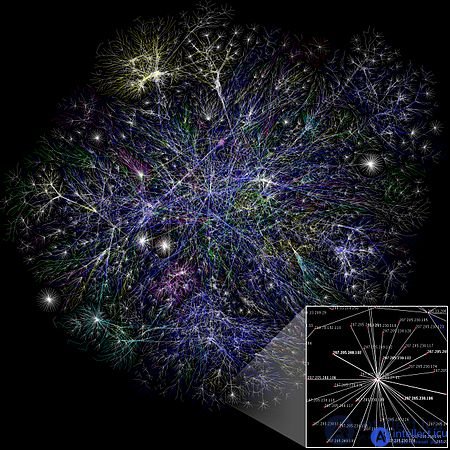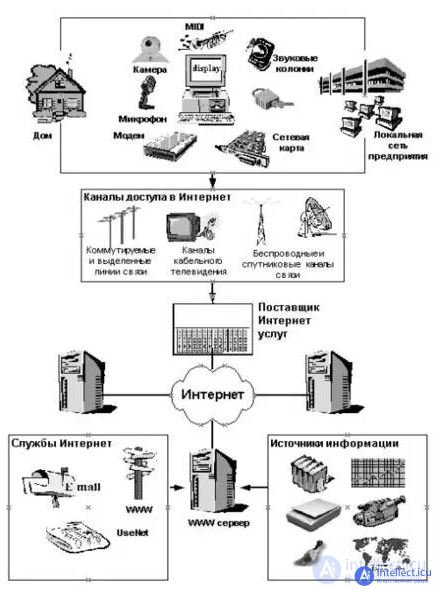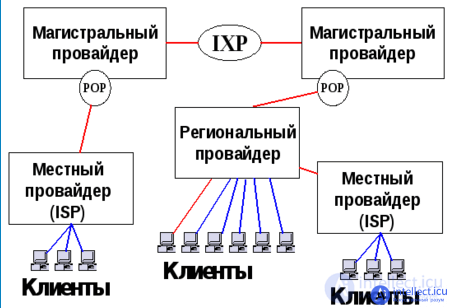Lecture
Internet is a worldwide system of united computer networks for storing and transmitting information. Often referred to as the World Wide Web and the Global Web, or simply the Web. Built on the basis of the TCP / IP protocol stack. The World Wide Web (WWW) and many other data transmission systems operate on the basis of the Internet .
By June 30, 2012, the number of users regularly using the Internet amounted to more than 2.4 billion people.In
other words, the Internet is interconnected networks,
it can be structurally depicted as

In 1957, after the launch The Soviet Union was the first artificial Earth satellite, the US Department of Defense believed that in case of war, America needed a reliable information transmission system. The US Defense Advanced Research Projects Agency (DARPA) has proposed developing a computer network for this. The development of such a network has been entrusted to the University of California, Los Angeles, Stanford Research Center, University of Utah, and California State University Santa Barbara. The computer network was named ARPANET (Advanced Research Projects Agency Network), and in 1969, as part of the project, the network united the four specified scientific institutions. All work was funded by the US Department of Defense. Then the ARPANET network began to actively grow and develop, scientists from various fields of science began to use it.
The first ARPANET server was installed on September 2, 1969 at the University of California, Los Angeles. The Honeywell DP-516 computer had 24 KB of RAM.
On October 29, 1969, at 21:00 , a communication session was held between the first two nodes of the ARPANET, located at a distance of 640 km - the University of California Los Angeles (UCLA) and the Stanford Research Institute (SRI). Charley Kline was trying to remotely connect from Los Angeles to a computer at Stanford. His colleague Bill Duvall from Stanford confirmed the successful transmission of each entered character by phone.
By 1971, the first program for sending e-mail over the network had been developed. This program immediately became very popular.
In 1973, the first foreign organizations from Great Britain and Norway were connected to the network via a transatlantic telephone cable, the network became international.
In the 1970s, the network was primarily used for sending e-mail, when the first mailing lists, newsgroups and message boards appeared.
In 1984, the Domain Name System (DNS) was developed.
In 1984ARPANET had a serious rival: the US National Science Foundation (NSF) founded the vast NSFNet (National Science Foundation Network), which was made up of smaller networks (including the then famous Usenet and Bitnet) and had much higher bandwidth than ARPANET. About 10 thousand computers were connected to this network in a year, the name "Internet" began to smoothly transition to NSFNet.
In 1988, the Internet Relay Chat (IRC) protocol was developed, making real-time communication (chat) possible on the Internet.
In 1989in Europe, within the walls of the European Council for Nuclear Research (CERN), the concept of the World Wide Web was born. It was suggested by the famous British scientist Tim Berners-Lee, who over the course of two years developed the HTTP protocol, HTML language and URIs.
In 1991, the World Wide Web became publicly available on the Internet, and in 1993 the famous NCSA Mosaic web browser appeared.
In 1995, the World Wide Web became the main provider of information on the Internet, surpassing the FTP file transfer protocol in traffic. The World Wide Web Consortium (W3C) was formed

The end user is connected to an Internet Service Provider (ISP) using a special communication channel (optical or copper cable, mtcghjdjlyst WiFi connections , Satellite connection, connections using networks of mobile operators 4G 3G, combined connections) and devices (router + modem).
ISPs are connected through traffic exchange points.
Combining networks of different architectures and topologies became possible thanks to the Internet Protocol (IP) and the principle of routing data packets.
The main point is that each computer has its own IP address (often unique), the number of a specific network, the corresponding routes.
Local, regional, backbone providers
Local (local) provider (ISP - Internet Service Provider) is an Internet service provider operating (as a rule) within the same city (YUGINFO, CTS, Intercable).
regional provider - one country, region, district (TransTelecomKavkaz, UTK, TsTS).
backbone provider - countries, continent, globe (Global one Orange), Golden Telecom, Rostelecom, Verizon, Cogent)
points of presence (POP), traffic exchange points (IX)

The core of the Internet (or Core Backbone Network) is made up of networks of so-called Tier-1 Network Server Providers or backbone providers, the largest of which are UUNET (purchased by Verizon), AT&T (in America), MCI (purchased by Verizon), GTE / BBN (together with AT&T in SBC) and Sprint (names often change due to the fact that some firms merge, others buy someone or become part of larger firms, and still others are renamed).
These networks are mainly based on SONET / SDH, DWDM, ATM technologies. The site https://intellect.icu says about it. Their backbones are characterized by 622 and 2488 Mbit / s channels, respectively. Sometimes there are channels of 9952 Mbps and even more.
The networks of backbone providers of the first level freely exchange traffic among themselves through IXP - Internet Exchange Point of traffic exchange point. Countries gain access to the core of the Internet either through Tier 1 backbone providers with POP-Point of Presence around the world, or local Tier 1 backbone providers... NSP Tier-1 networks freely exchange traffic with each other, with the bulk of this exchange concentrated in two zones (Metropolian Exchange Area, MAE), located in New York and San Francisco. Although the United States has the largest concentration of Tier 1 NSPs, the "distribution area" of these networks is not limited to that country. Other countries get access to the core of the Internet either thanks to NSPs of the first level, which have points of presence (POP-Point of Presence) around the world (for example, UUNET "reaches" both Europe and Southeast Asia), or local NSPs of the first level (this practice is widespread in Asia).
Below the backbone providers in the hierarchy are network providers of the next level - regional , interconnected by high-speed data transmission channels, which, in turn, provide access to the Internet for local ( local ) providers (Internet Service Privider, ISP). Individual users and client companies get access to Internet resources precisely through the ISP. The connection between ISP and users (private or corporate) is usually carried out using: dial-up lines (regular telephone or ISDN), satellite communications, ADSL, VDSL, WiMAX, mobile communications (2G, 2.5G, 3G) or through the so-called leased lines: FTTH (Fiber to the Home), ETTH (Ethernet to the Home).
Thus, the path between an arbitrary Web server and a user's computer consists of three main parts - the section between the Web server and the expressway, the section of the expressway, and the section that connects the user to the highway.
In communications jargon, the first section is usually called the " first mile " and the third " last mile ".
Insufficient data transfer rates can create troubles on both the first and last mile. However, the problems of the first mile are solved quite simply - it is necessary to transfer the server from the company office to the server center, which is directly connected to the backbone. This service is called collocation.
The last mile problem is much more serious. Its solution consists in the distribution of high-speed access systems using xDSL technology (primarily ADSL), cable television systems. In such systems, data transfer rates easily reach several megabits per second, which is sufficient for most applications.
Point Of Presence (POP), point of presence - the location of the operator's (provider's) equipment, to which customers can connect.
Typically, a POP is a communications center or data center, possibly a separate piece of communications equipment located closer to the concentration of potential customers, for example, in an office building. This term is used when planning data transmission networks and calculating their cost. Usually, the provider providing network connection or data transmission services indicates the cost of their services exactly at the point of presence. To determine the total cost, one should take into account the construction (lease) and operation of the communication channel from the point of presence to the client's equipment (the so-called last mile). Therefore, when planning networks, the territorial location of points of presence of various providers is of no less importance than the cost and technical characteristics of their services.
For example, when providing an Internet connection service, the last mile is the section from the switch port of the provider at his communication center to the port of the client's router at his office. For dial-up (dial-up) services, the last mile is the section between the user's modem and the provider's modem (modem pool). The last mile usually does not include internal wiring. The last mile technologies usually include xDSL, Wi-Fi, WiMax. The last mile equipment includes xDSL modems, access multiplexers, fiber optic modems and converters, and radio multiplexers. There are specialized companies and divisions of large communication companies that are exclusively engaged in building the last mile.
In Russia and many other countries, it is the last mile that holds back the expansion of the Internet audience, the introduction of new technologies, and the provision of new telecommunications services. The point is that the last mile is usually the narrowest section of the channel from the user to the service provider. Expanding this channel is quite expensive due to the dispersion of users.
IXPnternet eXchange Point (IXP), a traffic exchange point, is an infrastructure that allows different providers to exchange traffic.
They are created for unhindered traffic transmission between different providers without loading external trunk channels. In places where long-distance communication is poorly developed, local regional operators pay for traffic many times more than operators in the United States or Europe. Therefore, they organize traffic exchange points through which they pass extremely cheap traffic between their customers.
Currently, there are a large number of services on the Internet that provide work with the entire spectrum of resources. The most famous of them are:
DNS service , or the domain name system, which provides the ability to use mnemonic names for addressing network nodes instead of numeric addresses;
e-mail (E-mail), which allows one person to exchange messages with one or more subscribers;
an IRC service designed to support real-time text communication (chat);
newsgroups, or newsgroups (Usenet), which provide a collective messaging facility;
FTP service- a system of file archives, which provides storage and transfer of files of various types;
Telnet service designed to manage remote computers in terminal mode;
World Wide Web (WWW, W3, "World Wide Web") - hypertext (hypermedia) system designed to integrate various network resources into a single information space;
Streaming multimedia - watching online movies and listening to music online
for each software server are reserved standard TCP and UDP port numbers.
By service availability:
By the nature of the content:
By physical location:
According to the information presentation scheme, its volume and the category of tasks being solved, the following types of web resources can be distinguished:
In relation to the visitor:
The most popular Internet services today are:
Web Forums
Blogs
Wiki projects (and, in particular, Wikipedia)
Information sites
Korparativnye sites
Personal sites
Thematic sites
Sites with cartographic information
Online Stores
Online auctions
Bots
Social Networking
Service Network
E-mail and mailing lists
Newsgroups (mainly Usenet)
File exchange networks
Electronic payment systems
Internet radio
Internet television IPTV
IP telephony
Messengers
FTP servers
IRC (also implemented as web chats)
Search engines
Internet advertising
Remote terminals
Remote control
Multiplayer games
Web 2.0
Online trading
Comments
To leave a comment
Fundamentals of Internet and Web Technologies
Terms: Fundamentals of Internet and Web Technologies